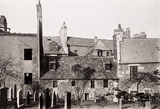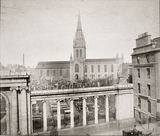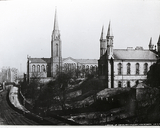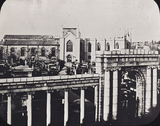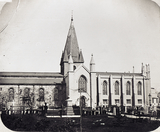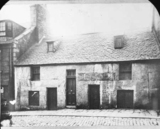|
Quick Search
|
Search Results
You searched for: More Like: 'Collison's Aisle, St Nicholas Church'
63 items
items as
Schoolhill
13 Old houses skirting St. Nicholas churchyard once formed part of the south side of Schoolhill. They were demolished in 1884-85 as part of a street widening scheme and the present wall and railing stand in their place. On the other side of Schoolhill (centre) can be seen the roof and turrets of George Jamesone's House, demolished in 1886.
The book Aberdeen in Byegone Days: Views of Streets and Buildings, etc. with Letterpress Description (1910) by Robert Anderson (page 26) suggests that the building in the centre of this image was the home of Burnett Carr, the grave-digger and assistant to the sexton of St. Nicholas Church.
Newspaper references indicate that Carr, a well known figure, died on 31st May 1844 (Aberdeen Journal, 5th June 1844, page 3, column 2).
This photograph looks north and shows the back of Carr's old house. Union Bridge
81 Union Bridge, Aberdeen, from Bridge Street, looking east. The spires at the left belong to Kirk House, later a restaurant and bar, and to St. Nicholas Church. The corner of the Palace Hotel is just visible at the right. Wallace Tower, Netherkirkgate
103 Wallace Tower in the Netherkirkgate looking towards St. Nicholas Church. The tower never had any connection with William Wallace. It is believed to have been the town residence of Sir Robert Keith of Benholm. The name "Wallace" may have been a corruption of "well-house". The Wallace Tower was re-sited at Tillydrone in the 1960s.
Correspondent Ed Fowler suggests that the ornamental building shown on the left at the end of the Netherhirkgate, next to the horse and cart, is the Dyers' Hall.
The name refers to the Dyers' or Litsters Society who were once an important and wealthy industrial group in Aberdeen. Newspaper notices suggest the building was used as a public house, where societies regularly met, and that it, and other buildings, were demolished in around 1807 to make way for a new street between Union Street and Tannery Street. Wallace Tower, Netherkirkgate
112 Wallace Tower in the Netherkirkgate looking towards St. Nicholas Church. The tower never had any connection with William Wallace. It is believed to have been the town residence of Sir Robert Keith of Benholm. The name "Wallace" may have been a corruption of "well-house". The Wallace Tower was re-sited at Tillydrone in the 1960s. Schoolhill from St. Nicholas Churchyard
120 This photograph taken in 1880 from St. Nicholas Churchyard looks north showing a row of houses which stood between it and Schoolhill.
These houses were demolished around 1884 as part of an improvement scheme to widen Schoolhill - named after the old Grammar School which stood nearby.
A dwarf wall with ornamental railings was erected in place of these buildings and a porter's lodge was removed from Robert Gordon's College to form a lodge for the sexton at the entrance to the churchyard.
The book Aberdeen in Byegone Days: Views of Streets and Buildings, etc. with Letterpress Description (1910) by Robert Anderson (page 26) suggests that the building in the centre of this image was the home of Burnett Carr, the grave-digger and assistant to the sexton of St. Nicholas Church.
Newspaper references indicate that Carr, a well known figure, died on 31st May 1844 (Aberdeen Journal, 5th June 1844, page 3, column 2).
This photograph looks north and shows the back of Carr's old house. View of Aberdeen from Cornhill
181 View of Aberdeen from Cornhill, c.1840. This picture was contained in a series of lithographs of Aberdeen published in 1840 by J and D Nichol, booksellers, Montrose. The elevated position of Cornhill provided one of the best points of view over the city. The idyllic rural scene in the foreground is in contrast to the array of smoking chimneys in the distance, interspersed with the spires of various buildings. In the middle is Broadford Textile Works with Hutcheon Street on the left. On the far right, there is the tall chimney of Rubislaw Bleachfield Works, which was demolished in July 1908. The spires belong to the East and West Churches of St. Nicholas, and the Tolbooth while, in the centre, there are the four turrets of the central tower of Marischal College and the tower of the North Church. The chimneys were evidence of the extent and importance of manufacturing in the city, while the western suburbs were the most attractive, with beautiful villas whose residents were often those citizens whose wealth came from these industries. St. Nicholas Church and Churchyard
185 St. Nicholas Church and Churchyard, from Union Streeet. The caption reads, "East and West Parish Churches, Aberdeen". The colonnade was designed by John Smith the City Architect in 1829. Monument to Dr William Guild
307 Monument in St. Nicholas Church graveyard to Dr William Guild, Incorporated Trades. Gaelic Chapel, Belmont Street
322 The Gaelic Chapel was founded in the 18th century in response to the increasing numbers of Highlanders who came to the city in search of work.
At first, they held services in the East Church of St. Nicholas but, in the 1790s, they obtained ground in the area between Belmont Street and Back Wynd, now known as Gaelic Lane.
The opening services in the new church were conducted on 30th August 1795. In 1843, at the Disruption, the whole congregation followed their minister, Rev. Hugh Mackenzie, into the Free Church.
By 1882, the church had become old and dilapidated and needed so much renovation that the congregation decided to move. The property was disposed of and was used as a printing office by G. & W. Fraser for a number of years.
The congregation moved to a church on Dee Street which had become vacant on the disbanding of the United Free Methodists and it was named St. Columba United Free Church.
In 1907, they amalgamated with the High United Free Church and moved to their church at the junction of Belmont Street and Schoolhill.
Comparing the scene shown here and large scale historic maps suggests that this is likely a view of the rear of the Gaelic Chapel buildings, looking north, potentially taken from the back of a building on Union Street. St. Mary's Chapel, St. Nicholas Church
366 A photograph of St. Mary's Chapel at St. Nicholas Church in around 1898.
Historic Environment Scotland's listed building information suggests this lower church was built in 1438. It was part of the 15th century expansion of St. Nicholas and located to the east of the then existing building. The main church was subsequently expanded eastwards over it.
Work was completed on the crypt in around 1507 and it was dedicated to the Virgin as Our Lady of Pity, from which derives the various names it has been known over the years; Pity Vault, the Cell of Our Lady of Pity, and St. Mary's Chapel.
The space has served many purposes since its creation and seen a number of renovations. It has been a general storehouse for sundry municipal items, including the gibbet, a plumber's shop, a public soup kitchen, a meeting place of the presbytery of Aberdeen, and a regular church.
More can be read about the chapel in Old Landmarks of Aberdeen (1885) by G. Gordon Burr and Alex. M. Munro, The Story of St. Mary's Chapel: The Ancient "Lower Church" or Crypt of St. Nicholas (1935) by The Rev. J. G. Grant Fleming and in the history section of the St. Nicholas Church website. St. Nicholas Church and Churchyard
374 St. Nicholas Kirk and graveyard, showing the new spire after the 1874 fire, which destroyed the ancient tower and steeple of the East Kirk. William Smith, son of John Smith, rebuilt both chancel and crossing between 1875 and 1877. When the present granite steeple was built, a carillon of 37 new bells was installed, cast by Van Aerschodt of Louvain, in Belgium. A further 11 bells were added in 1954, making a total of 48 bells - the largest carillon in Great Britain. St. Nicholas Church West, shown here, was built between 1751 and 1755. Designed by James Gibb, it is a classic example of an 18th century preaching kirk. Building took 4 years and it opened for public worship on 9th November 1755. St. Nicholas Kirkyard is a popular place for family historians, with its many table tombs and monuments. Amongst the famous local names are Archibald Simpson, architect, John Anderson, Wizard of the North, and William Dyce, the painter. St. Nicholas Church bell
382 A photograph of one of the bells installed in St. Nicholas Church in 1887.
A carillon of 36 bells were ordered by Aberdeen Town Council from Severin van Aershodt of Louvain in Belgium to replaced those destroyed in the fire of 1874.
The bells were also commissioned and installed to commemorate Queen Victoria's Golden Jubilee, marking 50 years of her reign. The largest of the new bells was named Victoria.
On 11th May 1887, the new bells arrived at Aberdeen Goods Station, after being shipped to Leith, where they were loaded on to lorries, and paraded through the main streets of the city on their way to Back Wynd.
The inscription on the shown bell reads as follows:
"The gift of Councillor George Washington Wilson. Cast by Severin Vanaerschodt, Louvain Belguim." Jamesone's House, Schoolhill
384 George Jamesone's House in Schoolhill. It was originally the manse of St. Nicholas church and became the home of the artist George Jamesone in 1620. By the time this photo was taken in 1885 the building was being used as a lodging house. It was demolished in the 1886 and the site is commemorated by a plaque on the wall of the property built in its place. St. Nicholas Church and Churchyard
488 St. Nicholas Church and Churchyard from Union Street. The colonnade was designed by John Smith in 1829. The Denburn Valley
498 The Denburn, Aberdeen. The Triple Kirks are in the distance with the spires of St. Nicholas Congregational Church in the foreground. In 1850, the Aberdeen Railway Co. which later amalgamated with the Scottish Midland Junction Co. to form the Scottish North Eastern Railway, brought the line from the south into the city. In 1864, after great debate, the Denburn Valley Junction Railway Scheme was adopted - forming a direct link between Kittybrewster and Guild Street. This photograph shows the commencement of the work. The new Joint Station opened in 1867. Aberdeen town centre
518 Aerial view of the centre of Aberdeen. The Church of St. Nicholas dominates the cityscape. Aberdeen across the Dee
605 An illustration looking north towards Aberdeen from the Kincardineshire (Torry) side of the River Dee.
Rowing and sailing boats are shown in the river. Various spires can be seen on the skyline: South Parish Church, built on Belmont Street in 1830, St. Nicholas Kirk and the Tolbooth. Triple Kirks, Denburn
668 The Triple Kirks were built to the design of Archibald Simpson to house three separate Free Church congregations in 1843/44.
Due to lack of funds, second-hand building materials were used (reputedly the down takings from the old Dee Village), and the spire, which was modelled on that of the Katherinenkirche, Magdeburg, is of 18th century Ferryhill brick.
The church in the foreground was designed by James Souttar and opened in 1865 as Belmont Congregational Church, becoming known as St. Nicholas Congregational in 1910. Its final service was held in 1995. St. Nicholas Church and Churchyard
744 St. Nicholas Church, without a spire following the fire of 1874, and Churchyard from Union Street. St. Nicholas Church with old spire
745 St. Nicholas Church with the old lead and wood spire, showing the churchyard. Schoolhill
756 These old houses skirting St. Nicholas Churchyard once formed part of the south side of Schoolhill. This photograph looks south, across Schoolhill, from in front of George Jamesone's House.
The shown buildings were demolished in 1884-85 as part of a street widening scheme and a low wall and railing now stand in their place. George Jamesone's House, on the other side of of the street, was demolished in 1886.
The book Aberdeen in Byegone Days: Views of Streets and Buildings, etc. with Letterpress Description (1910) by Robert Anderson (page 26) suggests that the building in the centre of this image was the home of Burnett Carr, the grave-digger and assistant to the sexton of St. Nicholas Church.
Newspaper references indicate that Carr, a well known figure, died on 31st May 1844 (Aberdeen Journal, 5th June 1844, page 3, column 2). |







